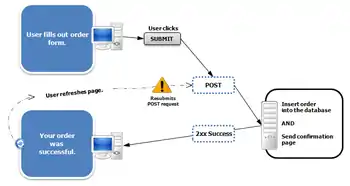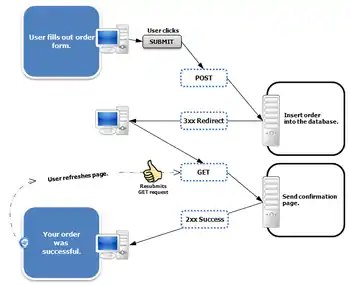Post/Redirect/Get
Post/Redirect/Get (PRG) is a web development design pattern that lets the page shown after a form submission be reloaded, shared, or bookmarked without ill effects, such as submitting the form another time.


When a web form is submitted to a server through an HTTP POST request, attempts to refresh the server response can cause the contents of the original POST to be resubmitted, possibly causing undesired results, such as a duplicate web purchase.[1]
To avoid this problem, many web developers use the PRG pattern[2]—instead of returning a web page directly, the POST returns a redirect. The HTTP 1.1 specification introduced the HTTP 303 ("See other") response code to ensure that in this situation, browsers can safely refresh the server response without causing the initial POST request to be resubmitted.
The PRG pattern cannot address every scenario of duplicate form submission. For example, if a web user refreshes before the initial submission completes, possibly because of server lag, a duplicate POST occurs in certain user agents.
Bookmarks
User agents (such as browsers) store only the URL of an HTTP request as a bookmark. Because of this, a response based on the body of the HTTP POST request cannot be bookmarked. With the PRG pattern, the URI of the request can safely be bookmarked.
References
- Grinberg, Miguel (2014). Flask Web Development (1st ed.). O'Reilly. pp. 44–46. ISBN 978-1-449-37262-0.
- Chisholm, Wendy; May, Matt (2008). Universal Design for Web Applications. O'Reilly Media, Inc. p. 36.
External links
- Redirect After Post, Michael Jouravlev, August 2004
- Description of the pattern for J2EE, Michael Jouravlev, August 14, 2003
- GET after POST Adam Vandenberg
- Doing the PRG in JSF1.2